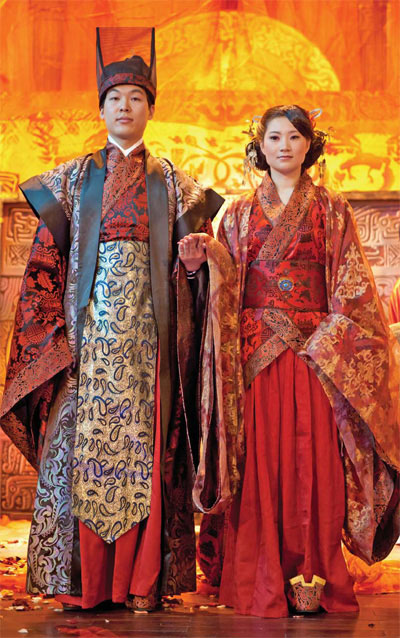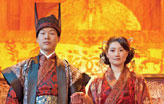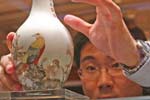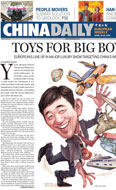Han me downs
Updated: 2011-04-15 11:58
By Liu Lu (China Daily European Weekly)
 |
|
Shi Jin and Wang Liying dress in traditional Han costumes for their recent wedding. Provided to China Daily |
Traditional 3,000-year-old clothes are making a comeback
A classical Chinese zither fills the air with serene sounds as a newly-wed couple walks slowly down the red carpet in a room decorated with luxurious golden veils and shining bronze ware. The young couple looks radiant and graceful in their traditional Han costumes, which are embroidered with elaborate red and golden patterns. Six female attendants, holding red lanterns, escort the couple along the red carpet, which is lined by guests. The wedding guests appear amazed by the striking elegance and beauty of couple, and feel as if they have traveled back in time.
This was the scene of a recent wedding ceremony held in Shenyang, in Northeast China's Liaoning province. It authentically reproduced the wedding ceremony of the ancient Han Chinese.
Such retro-style ceremonies involving hanfu (Han clothing) are becoming popular in modern China as more young people reach for their roots.
"The white bridal veil is beautiful, but they are sacred wedding dresses for Westerners," says Wang Liying, the bride at the grand Shenyang wedding. Wang is a doctorate student studying in Switzerland.
"Hanfu has lost out to popular Western-style clothing in Chinese people's everyday life, but my husband and I wanted to wear the dress of our own culture on the most important day of our lives."
Wang says many years of living overseas has made her more keen to embrace her own cultural heritage.
China's great philosopher Confucius considered the long Han robe as a required part of ceremonies and rituals and many of his quotations contain references to hanfu.
Further more, generations of Chinese believe hanfu is a token of a courteous lifestyle.
With a history of more than 3,000 years, hanfu has deeply influenced the designs of many traditional costumes of neighboring countries, such as the kimono in Japan, the royal and traditional dress in Vietnam and the hanbok of Korea. Although the style of hanfu may vary according to different historical periods there are a few constants: Y-shaped cross collars; long, wide sleeves; delicate embroidery, and the use of natural materials, such as cotton and silk.
Although hanfu is no longer the typical daily dress for contemporary Chinese it appears the refined long robe has recaptured public attention.
The revival began when hundreds of actors, wearing the traditional garment, performed in the opening ceremony of the Beijing 2008 Olympic Games rekindling keen interest in this almost forgotten apparel.
In 2009, an online survey of 1,200 people by Chinese portal website Sohu.com revealed that 80 percent believed the wearing of hanfu was acceptable and necessary for certain important occasions.
Interestingly, the recent hanfu craze has triggered heated discussion about whether it should be referred to as China's national costume.
"When talking about traditional Chinese clothing, people might immediately think of qipao, or cheongsam. But in a strict sense, hanfu is more suitable to be called as China's national dress due to its long history and glorious past," says Ren Guanyu, 35, the professional wedding planner for Wang's Han costume wedding.
Ren is also the founder of Han Yi Fang, one of China's largest studios specializing in producing high-quality Han costumes and providing traditional wedding services.
"The 300-year history of qipao is much shorter compared to hanfu, which has been around 3,000 years."
Compared to qipao, Ren believes hanfu is more likely to be accepted by common Chinese.
He says the wearer of a qipao requires a slender figure, however a well-designed hanfu covers up any imperfections.
And Ren says hanfu is making a comeback not only in China.
Overseas Chinese are becoming more passionate about their traditional fashion, because they regard it as formal dress that shows off their cultural identity.
Ren began his hanfu business in 2006 shortly after a trip to visit his wife who was studying a Master's program at the Cambridge University in Britain.
"While joining parties with my wife's classmates, I noticed that many foreign students wore their national costumes. But in contrast, Chinese were all dressed in Western-style clothes. It made me feel very embarrassed," he says.
The experience inspired Ren to open his hanfu business, and his confidence has been boosted by rising orders, proving the existence of this niche market.
"Half of the buyers are overseas Chinese," he says. "They drop by my shop to buy tailor-made hanfu when they are on vacation. But some of them even see hanfu as a new form of fashion evolution."
At Ren's shop, tailor-made hanfu ranges from 800 yuan (85 euros) to 4,000 yuan according to the materials and different levels of workmanship.
He is also considering bringing more modern elements into his Han costumes to make them more appealing to today's customers.
"We target high-end consumer groups, particularly those people living abroad because they are more frequently attending various social activities and the dress is became a very important symbol that embodies the wearers' cultural background," he says.
Since 2007, Ren's business has masterminded more than 100 Han costume weddings in Beijing and now he is busy promoting this new wedding fashion to more places of China.
"I hope people will get to know more about our own culture by having and attending traditional Chinese wedding ceremonies," he says.
While some hanfu enthusiasts dress up for fun, others believe the significance of wearing hanfu on formal occasions goes far beyond the costume's esthetic value.
"Han costume represents the true essence and is a carrier of Chinese traditional culture," says Chang Lanzhi, 26, organizer of Hanfu Beijing, a social group made up of more than 300 hanfu enthusiasts.
"We hope to call more people's attention to value the traditions left by our ancestors and the studies of Sinology."
Chang and her fellow members often dress in hanfu to perform ancient rituals or play classical Chinese musical instrument at traditional festivals.
They are also frequently invited to give lectures on traditional culture to students at Beijing's high schools and universities.
"In many countries, people will put on their traditional costumes on important occasions," she says.
"Yet we Chinese, who boast such a long history and with such a rich culture, only have Western suits. How can it represent our national self-esteem?"
Chang says the revival of hanfu reflects the people's consciousness with respect to traditional national culture.
"The more we globalize, the more we need to hold onto our own national identity," she says.
"If hanfu can help to promote people's understanding of Chinese culture and build up their self-confidence, why should it be rejected?"
E-paper

Han me downs
A classical Chinese zither fills the air with serene sounds as a newly-wed couple walks slowly down the red carpet in a room decorated with luxurious golden veils and shining bronze ware.
Fast growth fuels rise in super rich
Chinese tourists spend more
Reaching out
Specials

Share your China stories!
Foreign readers are invited to share your China stories.

No more Mr. Bad Guy
Italian actor plans to smash ‘foreign devil’ myth and become the first white kungfu star made in China.

Art auctions
China accounted for 33% of global fine art sales.
